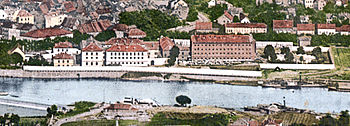Hameln prison

The prison Hameln, also known as the Stockhof, was a prison and penitentiary in Hameln . The penal institution, to which there was a predecessor institution since 1698, existed from 1827 to 1980. It was located between the old town and the Weser . Today there is a hotel in the listed prison buildings .
history
The prison goes back to the Stockhof built in 1698 . It housed prisoners who were condemned to build a fortress . The name is based on the fact that the prisoners in their dormitory were connected to a stick at night because of the risk of escape .
A new prison was built in 1713 due to overcrowding. In 1827 a new building was erected on the former site of the Hameln Fortress directly on the Weser , from which some of the remains of the buildings still exist today. Three wings and ancillary buildings were built. This was the royal penal institution that became a Prussian prison in 1866 .
time of the nationalsocialism
In the time of National Socialism , from 1933 onwards, hundreds of political prisoners were also imprisoned in addition to around 500 criminal prisoners. According to the National Socialist rulers, they were mainly communists and social democrats , but also homosexuals and Jews . In 1935 the outer walls were raised and the prison was converted into a penitentiary . During the Second World War , political prisoners came from France and Denmark, also as night and fog prisoners . According to official statistics, 305 prisoners died between 1939 and 1945, 55 of them after they were liberated by American troops. At the end of the war on April 5, 1945, during the bombardment of the city , the SS ordered the prison to be evacuated and the march to the Holzen subcamp , which for many prisoners became a death march along the Ith .
post war period
In the post-war period , the prison served as a place of execution for the British military government from December 13, 1945 until 1949 . The executioner was the Briton Albert Pierrepoint . 156 people were executed as war criminals during this period . Among them were the concentration camp guards Irma Grese , Elisabeth Volkenrath and Johanna Bormann convicted in the Bergen-Belsen trial , the camp commandant Josef Kramer , and the concentration camp doctor Fritz Klein . Other executions due to Allied trials also included concentration camp doctors Rolf Rosenthal , Hans Körbel and Benno Orendi , Vera Salvequart ( Kapo in Bergen-Belsen concentration camp), SS guards Ruth Neudeck , Dorothea Binz , Elisabeth Marschall and Emma Zimmer , the former battalion commander of the 12th SS Panzer Division Bernhard Siebken and Fritz Knöchlein , Chief of the 4th Company of the 2nd SS Death's Head Regiment .
Another 44 people were executed for violating occupation law. Among them were 42 former forced laborers, some of them Eastern European. The last execution in Hameln took place on December 6, 1949 of the Pole Jerzy Andziak (a displaced person ) for using firearms resulting in death.
In 1955 the Hameln penitentiary was closed and the inmates were taken to the Celle prison . On October 1, 1958, the prison became a juvenile detention center , the prisoners of which were transferred to the newly built Hameln juvenile prison in Tündern in 1980 . The prison operation ended. In 1986 the cell structure and the east and west wings of the facility were demolished. The remaining parts were converted into a hotel, which opened in August 1993.
Political prisoners in the time of National Socialism (selection)
- Emil Carlebach , Jewish trade unionist
- Arthur Gerlt , member of the Committee for Proletarian Unity
- Wilhelm Hahn junior , social democrat and resistance fighter
- Walter Krämer , communist
- Friedrich Lohmeyer , SPD functionary and resistance fighter
- Wilhelm Müller , communist
- Karl Schinke , Social Democrat
- Peter Schneider , Social Democrat
- Ernst Wesemann , social democrat
Executed under British occupation (selection)
- Dorothea Binz , concentration camp guard
- Johanna Bormann , concentration camp guard
- Irma Grese , concentration camp guard
- Franz Hößler , SS-Hauptsturmführer and Schutzhaftlagerführer
- Gustav Alfred Jepsen, SS-Obersturmbannführer
- Fritz Klein , concentration camp doctor
- Fritz Knöchlein , SS-Obersturmführer
- Hans Körbel , SS doctor, works doctor at Volkswagen
- Josef Kramer , concentration camp commandant
- Günther Kuhl , SS-Obersturmbannführer
- Max Pauly , concentration camp commandant
- Rolf Rosenthal , SS doctor
- Karl Eberhard Schöngarth , SS Brigade Leader
- Bernhard Siebken , SS-Obersturmbannführer
- Walter Sonntag , SS-Hauptsturmführer, concentration camp dentist
- Bruno Tesch , chemist
- Anton Thumann , SS-Obersturmführer
- Elisabeth Volkenrath , concentration camp guard
Web links
- The Hameln prison in the Nazi era and in the post-war period
- The Stockhof am Langen Wall - Hameln prison
- Map of the Hameln prison, 1952
- Aerial view of the prison in the early 1960s
- Benjamin Schulz: Parties in the Nazi prison. Spiegel online from May 25, 2011
Individual evidence
- ↑ Article on www.gelderblom-hameln.de
- ↑ Diana Schulle (ed.), Susanne Brömel, Christine Müller-Botsch , Johannes Tuchel (collaborators): Biographies: Wilhelm Hahn jun. ... on the page Sozialistische-front.de , publisher: German Resistance Memorial Center with the support of the Lindener Geschichtswerkstatt in the Linden leisure center
Coordinates: 52 ° 6 ′ 2.7 ″ N , 9 ° 21 ′ 14.9 ″ E

